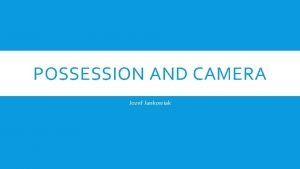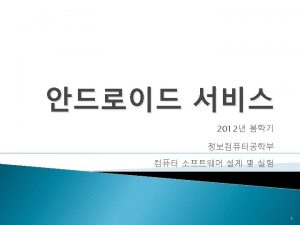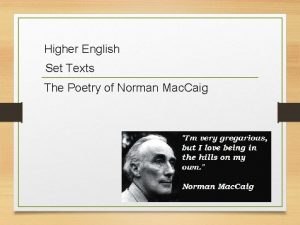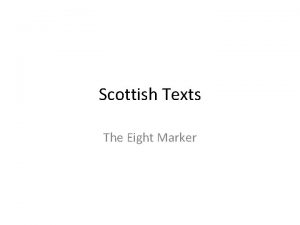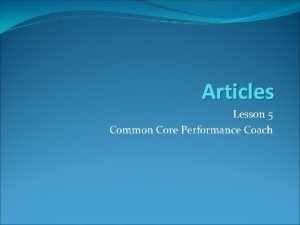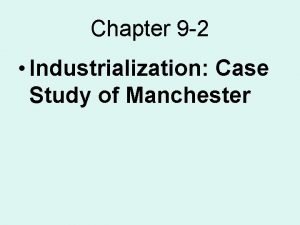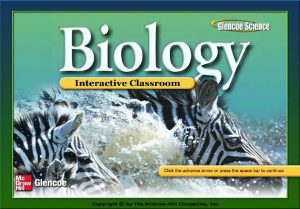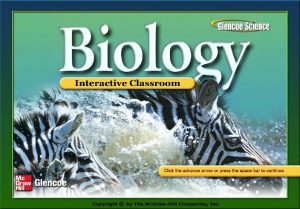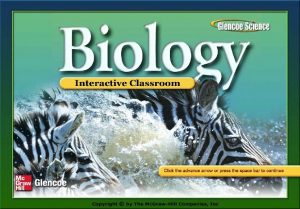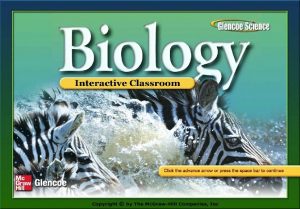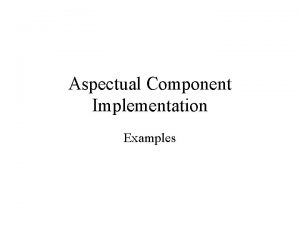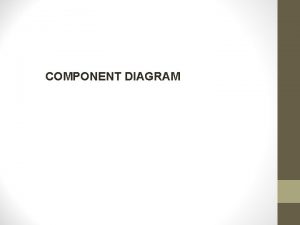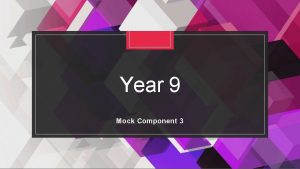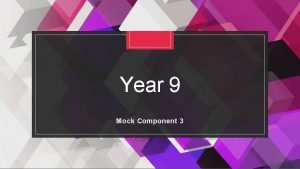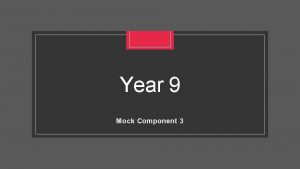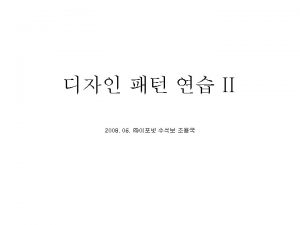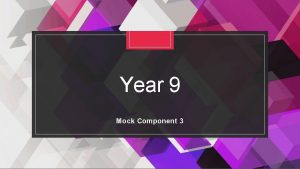NAME Component 1 Section 2 Set Text Study






























- Slides: 30

NAME: ____________ Component 1 Section 2 Set Text Study: Blood Brothers

Features of a Text Acts and Scenes Blocking Antagonist Link the following features of a text to their definition The spoken text of a play – conversations between characters – is dialogue. The character that is against the Protagonist The leading character or 'hero' in a play who has to fight against/oppose the ANTAGONIST. Character Instructions given by the author about how a play should be staged, when actors should make their entrances and exits and how lines should be delivered. Dialogue A speech within a play delivered by a single actor alone on stage Duologue A named individual within the play Flashback Monologue Plot In narratives, this term refers to a secondary plot or storyline. Subdivision between sections of a play. They are then subdivided further Part of a scene in a drama which is a scripted conversation between only two characters. Protagonist A moment during the action of a play when the natural flow of time is interrupted so that a moment from the past can be presented. Stage directions The basic story thread running through a performance/play which gives the reason for the characters’ actions. Subplot The process of arranging moves to be made by the actors during the play, recorded by stage management in the prompt script.

Theatre Makers Actors Choreographer Costume Designer Link the following Theatre Makers to their definition Responsible for the finances of the production. They also source the performers and teams. A member of the cast of a musical or play who knows the part of one (sometimes more)of the principal roles and is also in the chorus. Responsible for the design and production of everything on stage. Person (male or female) whose role is to play a character. Director Professional in charge of the design and plotting of the lights on stage Lighting Designer In charge of backstage calling the cues from the prompt corner and supervising props. Producer Playwright Set Designer Sound Designer Stage Manager Understudy Member of the creative team for a show responsible for the clothes worn by the actors throughout the performance. . The author of a play. Broadly, the role involves being responsible for the overall artistic vision of a production including characterisation, blocking and design. Member of the production team responsible for setting dances and movement sequences during the production. Member of the production team who has the responsibility for planning and executing the layout of all sound playback and reinforcement equipment for the show. This role also includes the sourcing of music and sound effects for the production.

Performance Design You will to memorise and understand the use of these design elements Lighting Design • Floodlight: Used to cover a large area with a general ‘wash’ (clear light) Also used to light a back screen. • Profile Spot: Creates a focused spot of light. The ‘gate’ can hold gobos (shapes) to create special effects. • Strobe Light: Creates flashes of light which can be controlled. • Follow Spot: Lights used to follow an actors movement on stage. • Gel: Colour tint which is place in front of the light blub to change its colour. • Cross Fade: Fading lights out on one stage area whilst bringing up lights on another area. Sound Design • Live: Door Slamming, whistling, popping balloons • Musical Instruments • Voices: offstage/signing • Recorded: Sound effects, recorded music • Amplification: Speakers, microphones • Volume: Loud, quiet • Pace: Fast, slow Use correct terminology in your answer and always justify your ideas in relation to the play!! Costume Design • Naturalistic Costume: Looks life-like, realistic, believable • Stylised Costume: Creative, open to interpretation, emphasises one element. • Colour: Red, blue, black, ect. • Fabric: Cotton, silk, wool, chiffon • Texture: Rough, smooth, silky, • Fit: Loose, tight, fitted, Hair and Makeup • Hair: Length/colour/style • Wigs: Colour, texture, length • Hair accessorizes: Ribbons, slides, clips • Makeup: Natural/Exaggerated • Colour palette Set Design Type of Stage: Theatre in the Round, Thrust, etc Naturalistic/Minimal: Realistic Abstract: Symbolic Props: Hand, Stage or Trim Set: Backdrop, Flats, Projection Material: Wood, metal, card, stage blocks cloth, etc Colours

Stage Directions Offstage Right Upstage Right (USR) Upstage Centre (US) Upstage Left (USL) Centre Stage Right (CR) Centre Stage (CS) Centre Stage Left (CL) Downstage Right (DSR) Downstage Centre (DC) Downstage Left (DSL) What do you notice about the perspective of the stage directions? Offstage Left

Theatre Areas Green Room Costume Room FLY SPACE ABOVE USED FOR STORAGE RIGHT WINGS Stage Apron LEFT WINGS Lighting Box: Normally at the back of the auditorium

Plot Summary • We see the final moments of Mickey and Edwards lives as the Narrator begins the tale • Mrs Johnstone, a struggling single mother of seven, finds out that she is pregnant with twins. Her employer, Mrs Lyons persuades Mrs Johnstone to give her one of the babies. • Mrs Lyons takes Edward and brings him up as her own, convincing her husband this is true. Mrs Johnstone goes back to work but fusses over Edward, leading to Mrs Lyons firing her. • Aged seven, Mickey and Edward meet and become best friends, along with Mickey’s neighbour Linda. The three get into trouble with the police when they begin to throw stones at windows. • Scared of Edward becoming close to his biological family, Mrs Lyons convinces her husband to move the family to the countryside. Soon afterwards, the Johnstone’s (and Linda’s family) are rehoused by the council. • As teenagers, Mickey and Edward meet again and they rekindle their friendship. Linda and the boys remain close throughout their teenage years before Edward goes to university. • After marrying a pregnant Linda, Mickey loses his factory job. Unemployed, Mickey is involved in a crime with one of his brothers, Sammy, and both are sent to prison. • Mickey becomes depressed and takes pills to help him cope, which he continues to take after being released. • After Mickey comes out of prison and starts a new job, Edward and Linda start a light romance. Mickey finds out and is furious so he finds Sammy’s gun and goes to find Edward at his workplace, the town hall. • Mrs Johnstone follows Mickey and tells him in front of Edward that they are twins. The police also arrive. • Mickey waves the gun around and it accidentally goes off, killing Edward. The police shoot Mickey. The twins both lie dead. Structure Cyclical Blood Brothers has a plot that starts with the ending then carries on in a linear order until it reaches the end again. Why do you think Willy Russell chose a Cyclical Structure for ‘Blood Brothers’? ……………………………………………………………… ………………………………………………………………. .

Key Themes Social Class The contrast between two different social classes forms the heart of the play. The leading characters can be seen to be social stereotypes, presented dramatically in order to emphasise certain important differences in social class. Russell does this to show the unfairness that it results in. Nature vs. Nurture The ‘nature versus nurture’ debate is exemplified through Mickey and Eddie. They are twins and so the difference in the way their lives turn out must be a result of their different upbringings and social positions. Russell uses the concept of twins to persuade us that attitudes in society influence peoples’ lives more than their individual efforts at wanting to do well. Russell’s play is deliberately objecting to a view of Margaret Thatcher’s right wing conservative government, who claimed that everyone who wanted to work hard could be successful. Education This theme is linked to social class. Russell shows that wealth brings different educational opportunities and these lead to very different lifestyles. Eddie and Mickey are educated differently. One goes on to university and a successful career in politics, the other takes on a factory job making boxes. Redundancy and lack of opportunity then lead Mickey to crime, drug addiction and depression. Without a better education Russell is saying that Mickey had few options, and so we are asked to see Mickey’s mistakes in a sympathetic light. The effects of education shape the lives of the women in the play too. When Mrs Johnstone loses her husband she falls into poverty, from which her lack of education has provided her with no easy means of escape. She can only acquire unskilled work and has to rely on the State for housing. Compare her with Mrs Lyons who similarly, despite presumably a middle-class education, is not self-reliant. In this case Russell is suggesting perhaps that the traditional lives the women lead have less freedom, even when they are educated.

Fate and destiny Each of the leading characters is presented as being trapped and plagued by various kinds of misfortune and bad luck. Russell seems to be asking us to consider whethere really is such a thing as fate or destiny or whether life pans out because of natural rather than supernatural reasons, because of the way we are educated and live. Choose a theme and explain how as a Director you would highlight it within the stage production of ‘Blood Brothers’ …………………………………………………………………………………………………………… …………………………………………………………………………………………………………… …………………………………………………………………………………………………………… …………………………………………………………………………………………………………… …………………………………………………………………………………………………………… ……………………………………………………… Growing Up Life, for the children, is shown to be a carefree game in Act One. However the pressures of growing up in different backgrounds and educational systems are shown to bring problems later on. It is the different experience of growing up that ends the friendship between Edward and Mickey. For example after Mickey loses his job Edward tries to be positive about his situation but Mickey tells Edward that he cannot understand living on the dole. He says that Edward hasn’t had to grow up like him, to face the difficulties of the adult world and that they don’t have anything in common any more. Don’t forget to think about different elements of a play like • Stage Space and Design • Costume • Lighting • Sound • Props • Characterisation • Proxemics and Blocking

Willy Russell was born in 1947 into a workingclass family near to Liverpool. He left school at 15 without academic qualifications and became a hairdresser. By the age of 20 he felt the need to return to education and, after leaving university, he became a teacher at a comprehensive school in his home city. During this time Russell wrote songs for performers and for radio shows. One of his early plays was about the Liverpool pop group the Beatles. He has a love of popular music and this can be seen in many of his plays, but especially in Blood Brothers. One of the playwright’s aims is to show us that there are disadvantages to being poor and working class. The failure to succeed in life is not because of a lack of ability, but a lack of opportunity. This can clearly be seen in Edward and Mickey. Liverpudlians are known for their warmth, hospitality and wit. Liverpool is also famous for its football teams and impact on culture – the Mersey Beat (poetry), the Beatles (music) and playwrights, architects etc. Mrs Johnstone’s wit and warmth typify these qualities. Liverpool, because of its position on the River Mersey, was a prosperous seaport in the 19 th century. It is a city of many contrasts. In the 20 th century, because of the silting of the river, it was a place of financial depression, which led to unemployment and strikes. There was a big gap between the rich and the poor. How has Willy Russell’s upbringing inspired the story of Blood Brothers? ……………………………………………………………………………………………………………………………………………………………………………………… ……………………………………………………………………………………………………………………………………………………………………………………… ……………………………………………………………………………………………

The play is set between the 1960’s and 1980’s 1960 1970 Historical Context The play was written in and influenced by the events of the 1980’s ‘Youth culture’ was becoming more evident in the 1960’s. Teenagers who enjoyed music, fashion and culture were making themselves heard more and they were often associated with freedom and potential. Teenager’s started to believe the had the power to change the future and started to be more involved in protesting the issues they believed in. During the 1970’s Britain was in a recession and unemployment was becoming a major issue. Britain’s traditional industries that had once dominated the work force in our towns and cities (such as coal mining and ship building) were struggling to keep up with competition from abroad. There was a strong class divide in Britain between the working and middle class. Many working class parents found it difficult to afford even basic things such as food, clothes and heating. The Middle class who worked in jobs like accountancy or teaching, were largely unaffected by the industrial decline which strengthened the divide between them and the lower classes. 1980 1990 In 1979 Margaret Thatcher became Prime Minister. She made the decision that Britain’s traditional industries should be shut down. This had a huge impact on working class communities where a huge amount of men were left unemployed and having to sign on to the dole. This led to an increase in depression and crime rates. One of Thatcher’s central political beliefs was that success came to those who chose to work hard. Liverpool was previously a major port which led to it being highly effected by the industrial decline. In the early 1980’s Liverpool had one of the highest unemployment rates in the country with some men turning to crime and gangs to support their families. There were also riots on the streets that were fuelled by the men’s anger at the decisions being made in government. Mickey, Edward and Linda’s teenage years are represented in a very positive light with a montage of them enjoying them selves at the beach and the rifle range. The Narrator Emphasises how ‘Care free’ they are at the time Mickey finds work in a factory to support his family and works hard there but is soon made redundant. He spends three months looking for work with no luck and is forced to sign on to the dole. Edward sees Mickey at Christmas and meets a very different man. The loss of his job has left him angry and powerless. Edward talks about money as if it means nothing and Mickey show him the harsh reality of a working class life In Blood Brothers, Russell contradicts Thatcher’s view. He shows that money and influential connections are necessary to become successful. Mickey's failure, despite his good character and hard work, is the basis of the tragedy in the drama. Mickey’s unemployment prompts him to turn to crime. Once imprisoned for his crime he sinks further into depression.

Social Context Education Many middle class parents could afford to send their children to private school, this often led to university and a well paid job. In contrast, for most working class children living in rough areas, the schools were under funded and could not offer the same opportunities. When leaving school they needed to work to support their families and became stuck in the same low paying jobs for life. Mrs Johnstone is used to ‘living life on the never’. She buys toys and furniture from the Catalogue Man and when she can’t pay for them they are taken away. We hear voices of her seven kids complaining about never having anything. Edward goes to university and walks straight into a high paying job on the county council. In contrast Mickey finds work in a factory but is quickly made redundant and forced to sign on to the dole. Housing Council houses were the homes of most working class people in the 1950 s and 1960 s. The terraced houses had a lot to recommend them, but they were also cramped and lacked inside toilets and bathrooms. They did not have central heating and were heated mostly by coal fires. Their inner city locations were often dirty and there was nowhere for children to play as they rarely had gardens. New Towns To improve standards of living, the government moved people away from the terraced houses into new council accommodation in the countryside. ‘New’ towns were created like Skelmersdale, and existing places were developed, like Runcorn and Winsford. Some high rise blocks were built also. Mrs Johnstone’s family is certainly helped by their move, although not as much as she had hoped. In many ways, it is already too late for the older children, and the unemployment situation was often worse away from the city. Also, many missed the people and the amenities that they had known before, and the support network that existed all but vanished. Uprooting people can cause stress and depression.

Cultural Context Pop culture After the 1950 s society went through massive changes. As a result of young people gradually having more money, popular culture (music, TV and film) flourished, becoming accessible to a much wider public. Even the poorest in society, people would have had the chance to go to the cinema or to a club for dancing. Bands like The Beatles (who came from Liverpool) had huge fan bases and their music represented the feeling of being young and free The working class boys love of playful but ‘violent’ games, playing at cowboys and gangsters is influenced by films. Marilyn Monroe was a very famous Hollywood actress. Her image was well known even to people who did not watch her films. She was presented by the media as a kind of ‘perfect’ fantasy woman and she was shown to live a glamorous and carefree lifestyle. The reality was often very different. She needed anti-depressants and eventually died from an overdose of pills. Mrs Johnstone’s love of ‘dancing’ is a love of escape from her everyday life. She sings about going dancing with Mr Johnstone and how as she grows up and becomes a single mother of seven she misses it. Film and Television The rise of advertising and colour television meant that even children were exposed to things like films, television programs and celebrities in a way they hadn’t been before. Young people often imitated characters from film and television. Russell uses references to Monroe throughout the play. At each point he refers to a different aspect of her life and public image. Mrs Johnstone enjoys the glamour of Monroe's public image. Later in the play Mickey becomes hooked on anti-depressant ‘nerve pills’ and this is compared to Monroe's own depression.

Genre: The Type of Performance Musical A musical is a play in which music, lyrics and dance are used to express emotion and move on the storyline. Give three examples of how we know that ‘Blood Brothers’ is a Musical 1………………………………………………… ………………………. . . . 2…………………………………………………… 3………………………………………………… …………………………. Blood Brothers contains elements of more than one Genre Tragedy A Tragedy is a play dealing with tragic events and having an unhappy ending, especially one concerning the downfall of the main character. It is often clear to the audience from the beginning that it will not end well. Give three examples of how we know that ‘Blood Brothers’ is a Tragedy 1………………………………………………………… …………. . . . . 2………………………………………………………… ……………………………… 3………………………………………………………… ……………………………… Comedy A Comedy is a play that is intentionally funny either in its characters or its action. Give three examples of how we know that ‘Blood Brothers’ is a Comedy 1………………………………………………… ………………………. . . . 2…………………………………………………… 3………………………………………………… ………………………….

Style: How the play is performance Musical Within Musicals, acting can often be slightly melodramatic and the characters emotions are often expressed through song. Naturalistic When acting in the Naturalistic style the actors must make the audience believe that what is happening on stage is real. Their emotions must be true to life and expressed in a realistic way. Non-Naturalistic performances contain performance conventions that could not happen in real life and are therefore not believable to the audience. They can however express emotions and ideas to the audience that may not be possible through Naturalism. . Blood Brothers contains elements of more than one Style Conventions: Techniques used in performance Tableaux A large group picture involved many characters to represent aparticular moment in a story or drama, or to replicate a photograph or artwork for deeper analysis. Multi-Rolling Playing more than 1 role within a performance. In Blood Brothers the Narrator plays more than one role. (Milkman, Judge, Catalogue Man) Flashback The very beginning of the play when a death is revealed. This scene is repeated at the end of the play created a Cyclical structure. Narration The role of the narrator appears throughout the whole play. He has a menacing and threatening manner. He speaks in rhyme and we are supposed to get the feeling that he isn’t really present on stage rather a Montage In Act 2 the Narrator describes Linda, Mickey and Edward as particular points in their life. This scene is centred at the beach where Mickey, Linda and Edward are taking photos. Monologue Mickey ‘I wish I was our Sammy’

Multi-Rolling The narrator plays several different characters who are all very negative and unsympathetic towards the protagonists • The Milkman- Won’t give Mrs Johnstone any milk even though she is pregnant. • The Gynaecologist- Very abruptly tells her she will have more ‘Mouths to feed’, playing on her worries. • The teachers- Both teachers treat the boys badly by humiliating Mickey and threatening to beat Edward. Language The Narrator speaks differently to the other characters on stage using old fashioned sentences and rhyme. This enhances the feeling that he is not really there. “Did y’ never hear of a mother, so cruel” “Now y’ know the devil’s got your number” The Narrator Tension The narrator has a very menacing and threatening manner. He lurks above and on the edge of the scenes and is very judgemental of the characters. He speaks of the devil and superstitions and wears black as if attending the boys funeral. He moves in and out of the scenes and cannot be seen most of the time In Act 1 Mrs Johnstone swears on the bible that she will give Mrs Lyons her child. As a director, how would you integrate the narrator into this scene to create a tense atmosphere? ……………………………………………………………………………………………………………………… ……………………………………………………………………………………………………………………… …………………

Characters: Mrs Johnstone is a single mother who struggles to provide for her many children. She is loving and optimistic but makes some irresponsible decisions due to her impressionable and superstitious nature. She gets scared when she see’s “Shoes on the Table” and Mrs Lyons exploits her superstitions by making her swear on the bible. Voice Key Words Accent Pitch Pace Articulation Tone Projection She tells Mrs Lyons that she “loves the bones” of her children and forgives them when they misbehave. Even though she’s been through her husband leaving her, having to give up her child, been moved from her home she stays optimistic “Ey, we’ll be alright out here, son” She fell for her husband when he “gave her the chat” and is manipulated by Mrs Lyons She orders items from catalogues to give her kids a good life but as she is unable to pay for them they get repossessed. List 3 ways Mrs Johnstone might use her voice within Blood Brothers and explain what they show to the audience. Voice Justification

Characters: Mrs Lyons is wealthy but unhappy. Her need for a child causes her to manipulate Mrs Johnstone into giving her Edward. Once she becomes a mother she struggles to bond with Edward and hides it by being over protective and insecure. Her paranoia progressively drives her mad She becomes paranoid about Edward’s relationship with the Johnstone’s. This causes her to approach Mrs J where her madness peaks as she tries to stab her. Physicality Key Words Posture Body Language Facial Expressions Tension Status Proxemics Angles Mrs Lyons is a typical middle class woman of the 60’s era. Her husband has a high playing job and she stays at home. She feels like she has failed as a woman as she is unable to have children. Her home feels empty and feeds her desperation. She seeks constant reassurance that she is a good mother from Edward and doesn’t let him play out with other children. She exploits Mrs Johnstone’s poverty and superstitions “how can you possibly avoid some of them being put into care? ” and when Mrs J threatens to take back Edward she makes up a superstition about twins who meet again will die. List 3 ways Mrs Lyons might use her physicality within Blood Brothers and explain what they show to the audience. Physicality Justification

Characters: Mickey Johnstone Mickey is the twin Mrs Johnstone keeps. As a child he is very naughty but also very sensitive and loving. Growing up he starts to become insecure, particularly around girls. In adulthood he works hard at his job so after losing it and being arrested he sinks into depression. Mickey has an emotional breakdown when he is sentenced. He starts to take anti-deppressants to solve his low self-esteem and resentment of Eddie. Physicality Key Words Posture Body Language Facial Expressions Tension Status Proxemics Angles In his monologue Mickey shows how he is influenced by his older brother Sammy “Wee’s straight through the letter box”. The foreshadows the fact he is later influenced by Sammy to commit a crime The other children upset Mickey easily and he cries when they chant about dying. He is very close with his mother and notices her emotions. Mickey is a working class character and gets a low paying job because of his lack of success in education and it’s what he’s expected to do. When he loses his job he walks the streets for months trying to find another one. Although Linda makes her feelings for him very clear he is unable to tell her how he feels. He is also insecure about his intelligence and appearance, covering it up by acting the fool in lessons. List 3 ways Mickey might use his physicality within Blood Brothers and explain what they show to the audience. Physicality Justification

Characters: Eddie Edward Lyons Edward is the twin that Mrs Johnstone give away. He has had a privileged upbringing and is very polite with everybody, no matter their class. He rebels against his mothers strictness but still does what is expected of him as a middle class man. Edward can be naïve and proves he isn’t loyal to Mickey. Although he and Mickey seem like the best of friends, Eddie asks Linda to marry him after Mickey has a go at him and later they have an affair. Voice Key Words Accent Pitch Pace Articulation Tone Projection Mr and Mrs Lyons provide Edward with everything he wants as he’s growing up with “all his own toys “ and silver trays to take meals on”. However, he is happy to share all he has. Edward is happy to be in either Middle or Working Class environments, adapting his behaviour to suit whoever he is with. After returning from university Eddie show a complete lack of understanding of Mickey’s situation by saying he should “draw the dole” and “live like a bohemian”. By going to the other side of town when his mother forbids him he shows a rejection of his middle class roots but quickly goes back to them once at university and getting a job on the council. List 3 ways Edward might use his voice within Blood Brothers and explain what they show to the audience. Voice Justification

Characters: Linda She is not afraid to compete against the boys and stands up for Mickey when he gets emotional. Linda as a young girl is strong, confident and open with her feelings. However, in contrast, as she grows up she starts to conform to gender stereotypes. Linda’s affair with Edward is a turning point in the play, leading to the dramatic ending Voice Key Words Accent Pitch Pace Articulation Tone Projection Linda is constantly telling Mickey she loves him when they are teenagers. However, she still waits for him to make the first move. Linda loves both Mickey and Edward (in a way) but when she becomes pregnant in this era her decision is made for her. After Mickey’s time in prison and his depression, Eddie represents the freedom of her youth that she has lost. Linda becomes a stereotypical housewife, allowing Mickey actions to dictate what their life will be. Her sole focus is her husband her child. List 3 ways Linda might use her voice within Blood Brothers and explain what they show to the audience. Voice Justification

Characters Mr Lyons and Sammy A high flying business man who often works away from home. He becomes the managing director of the factory where Mickey worked before Mickey was made redundant Mr Lyons A high flying business man who often works away from home. His distance is made up by the fact that he can provide money for the house and for expensive schooling for Edward. He seems indifferent to the people whose lives he can directly affect - his workforce. He sends Mickey a heartless redundancy letter. Mr Lyons prefers not to become involved in affairs. Often treats his wife Mrs Lyons like a child. Sammy ‘Wees straight through’ the neighbours letter box and burns his school down. His use of a gun during his childhood games foreshadows his future crimes. He later robs a bus conductor at knifepoint and shoots a man during the robbery. As Mickey’s father leaves before he is born Sammy is the only male role model he has. Sammy Mickey looks up to Sammy as a role model when they are children. As a child he is incredibly naughty and as he grows up his behaviour gets progressively worse. Sammy uses his influence over Mickey to get him in to trouble but he shows no loyalty to him when everything goes wrong. Sammy persuades Mickey to join in the robbery by reminding him of everything he hasn’t got. Sammy is a stereotypical working class youth of this time, turning to crime instead of working hard. When the robbery goes wrong and Sammy has shot a man he runs out on Mickey.


Audience Perception Proxemics Within ‘Blood Brothers’ the characters have certain preconceived judgements of the protagonists. However, we as the audience have a different perception as we are shown the characters internal struggle through songs and monologues. Towards the end of Act 1 the policeman takes both Mickey and Edward home. How does Russell show the different perceptions that the policeman has of Mickey and Edward? . . . . . . . . . . . . . . . . . . . . . . . . . . . . . . . . . . . . . . . . . . . . . . . . . . . . . . . . . . . . . . . As an audience how do we perceive Mickey and Edward in this scene? . . . . . . . . . . . . . . . . . . . . . . . . . . . . . . . . . . Proxemics can be used to analyse characters relationships. As actors we can convey two or more characters relationships by thinking about their distance from each other and how they are positioned. If you were directing the scene in act 1 where Mickey and Edward first meet, how would you direct the actors to show their change in relationships through proxemics? . . . . . . . . . . . . . . . . . . . . . . . . . . . . . . . . . . . . . . . . . . . . . . . . . . . . . . . . . . . . . . . . . . . . . . . . . . . . . . . . . . . . . . . . . . . . . . . . . . . . . . . . . . . . . . . . . . .

Act 1 1. Swearing on the Bible Mrs Lyons asks Mrs Johnston to swear on the Bible that she will give 1 of her babies to her and keep this a secret. 2. Mickey and Eddie First Meet These two characters meet in the park and have no idea they are brothers. They call each other ‘Blood Brothers’ when they find out they have the same birthday. 3. Policeman Mickey, Linda and Eddie are caught throwing stones The policeman visits Mrs Johnstone and warns her harshly that any more trouble from her children will mean a court visit. In contrast, he then visits Mrs Lyons but chooses to explain away the trouble as merely a childish ‘prank’. He asks her to make sure Edward ‘keeps with his own kind’. Key Scenes: Make sure you understand what is happening in these scenes. Act 2 4. Teenagers on the Bus Mickey is on the school bus with Linda when Sammy pulls out a knife and threatens the conductor for a cheap ticket before running off. Linda tells Mickey she loves him, but only if he doesn’t become a criminal like his brother. Mickey doesn’t know how to tell Linda he loves her. Edward recommends they go to see sex films at the cinema to ‘see how it’s done’. 5. Made redundant Mickey loses his job. due to the ‘global slump’ his services are no longer required. Edward comes back from university for Christmas, well dressed and happy. Mickey doesn’t share his happiness. Edward doesn’t see the problem of living life ‘on the dole’ but Mickey feels that he just cannot begin to understand. Mickey explains that he has had to grow up and become an adult, while Edward can happily still play around like a kid. He feels they no longer have anything in common and he tells Edward to ‘beat it’. 6. Downhill Mickey goes to prison for armed robbery set up by Sammy’s gang. Once out he relies on antidepressants. Linda has found Mickey a job and a new home. Mickey is angry and knows who really sorted their lives out and gave him the job. It was Edward, now grown up and known as Councillor Eddie Lyons. 7. Love Triangle Edward kisses Linda and Mrs Lyons tells Mickey that Edward and Linda are seeing each other. Mickey takes a gun that Sammy had hidden under the floorboards. Mickey charges into town to look for Edward who is in a meeting. There is a commotion amongst the audience and Mickey approaches the stage pointing his gun at Edward. Mrs Johnstone to reveal to him that Edward is actually his twin brother The police arrive. Waving his gun in a frenzy at Edward, it accidentally goes off and Edward is killed. The police shoot Mickey.

Which question should I answer first? 1. Start with Section A multiple choice (to build your confidence) 2. Section C: Live Theatre Review (32 marks) 3. Section B: In order to build up skills and understanding. Exam 1 hr 45 minutes How long should I spend answering each question? Section A: 5 minutes Section B: 1: 5 minutes, 2: 10 minutes, 3: 15 minutes, 4: 25 minutes. Section C: 40 minutes 5 minutes spare to check work Top Tips How can I approach the written exam? What should I remember to do most? • Always justify your ideas: explain why. • Design Question in Section A: Link your ideas back to the time period in Liverpool. • Double, double check what character the question is asking you to talk about! Mr and Mrs are two different characters. How can I safe time? • Write Mrs J, Mrs L, Mr L in replace of full names. The examiner will still understand. • Diagrams and sketches can be used for the design question as long as you justify your ideas. You CAN take a clean copy of the play into the exam!

5 mins How to answer a 4 mark question WHAT- HOW-WHY Tip It is important that you justify your ideas- don’t just describe. Always a design question ü Costume ü Set ü Lighting ü Sound Costume: Colour, fabric, accessorises, hairstyle, time period, understanding of character. Set: Stage directions, Colours, textures, material, scale/size, levels. , entrances/exits. Projections, backdrop, floor space. What would you use? Lighting Stage directions, Colours, brightness, cue. How would you use it? Sound Live, recorded, volume, pace, tone, cue, effects. Why would you use it?

10 mins How to answer an 8 mark question WHAT-HOW-WHY “Describe how you would use vocal and physical skills to perform (given line)” Step 1: Outline what is happening in the scene (At this point in the play/In this scene) 1 sentence will be enough. Step 2: Identify how you want to play the character saying the line. (I want to show this character as/ I would want to establish that/ I would present) Physical Skills Step 3: Make 3 physical points (must link to your idea of character) Describe and explain What would you do? What would this show? Step 4: Make 3 vocal points (must link to your idea of character) Describe and explain What would you do? What would this show? Vocal Skills

15 mins How to answer a 12 mark question YOU WILL NEED TO TALK ABOUT BOTH CHARACTERS FOR HIGHER LEVELS! WHAT-HOW-WHY-LINK Step 1: . Briefly explain why is this scene is (comedic/has tension) Show the examiner you understand what’s happening in the scene. Step 2: Talk about the scene in its order and ensure you use quotes from the extract to show the examiner which part you are talking about. Try and talk about the beginning, middle and end of the extract. Step 3: Talk about your ideas (mention at least 4 between performance space and interaction) • When this happens (direct note form the script) • I would (performance space or interaction) DETAIL! • This would create tension/comedy because… “Explain how you might use performance space and interaction with others to create (tension/comedy. . ? ) for your audience. ” Performance Space Interaction with others

25 mins How to answer a 20 mark question WHAT-HOW-WHY-LINK Step 1: . Briefly explain what is happening in this scene and comment how this scene contrasts to another. “At this point of the play (character) is… in contrast to the beginning/end of the play when (character) is. Step 2: Talk about this extract in detail and how you would use your physical skills. Comment on contrast/similarities from another scene. Step 3: Talk about this extract in detail and how you would use your vocal skills. Comment on contrast/similarities from another scene. • Write in detail • Write about the whole of the extract • Comment on scenes across the whole of the play. ““Describe how you would use your acting skills to interpret [CHARACTER] in this extract and explain why your ideas are appropriate both for this extract and the rest of the play. ” Physical Skills Vocal Skills Performance Space Interaction with others
 Making connections
Making connections Total set awareness set consideration set
Total set awareness set consideration set Training set validation set test set
Training set validation set test set Set view target with blend camera component
Set view target with blend camera component Name
Name Component name
Component name Component name
Component name Bounded set vs centered set
Bounded set vs centered set Fuzzy theory
Fuzzy theory Crisp set vs fuzzy set
Crisp set vs fuzzy set Crisp set vs fuzzy set
Crisp set vs fuzzy set What is the overlap of data set 1 and data set 2?
What is the overlap of data set 1 and data set 2? The function from set a to set b is
The function from set a to set b is Gas cutter with cylinder price
Gas cutter with cylinder price Aunt julia poem analysis
Aunt julia poem analysis The final question
The final question Ecological study vs cohort study
Ecological study vs cohort study Retrospective cohort study
Retrospective cohort study Critical examination in method study
Critical examination in method study Marty lobdel
Marty lobdel Phytogeographical regions of world
Phytogeographical regions of world Objective of work study
Objective of work study Time and motion study example ppt
Time and motion study example ppt Lesson 5 articles answer key
Lesson 5 articles answer key Chapter 3 section 1 community ecology answer key
Chapter 3 section 1 community ecology answer key Manchester2
Manchester2 Study guide chapter 5 section 1 biodiversity
Study guide chapter 5 section 1 biodiversity Population ecology chapter 4 answers
Population ecology chapter 4 answers Study guide chapter 35 section 1 the digestive system
Study guide chapter 35 section 1 the digestive system Chapter 31 section 1 basic behaviors study guide answer key
Chapter 31 section 1 basic behaviors study guide answer key Chapter 29 section 1 reptiles study guide answers
Chapter 29 section 1 reptiles study guide answers



